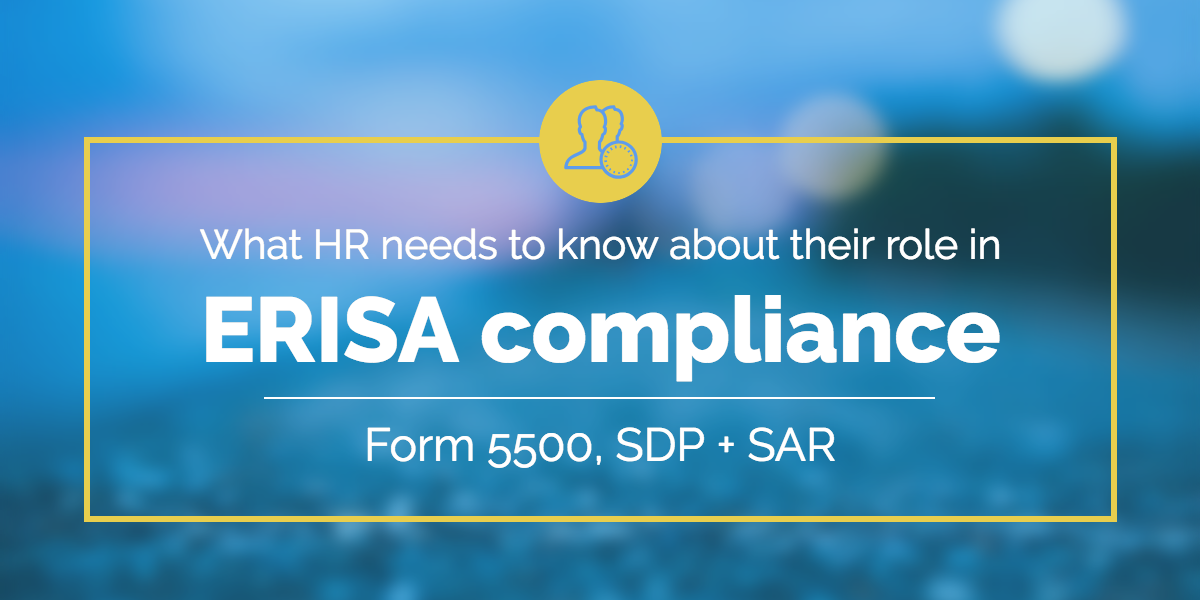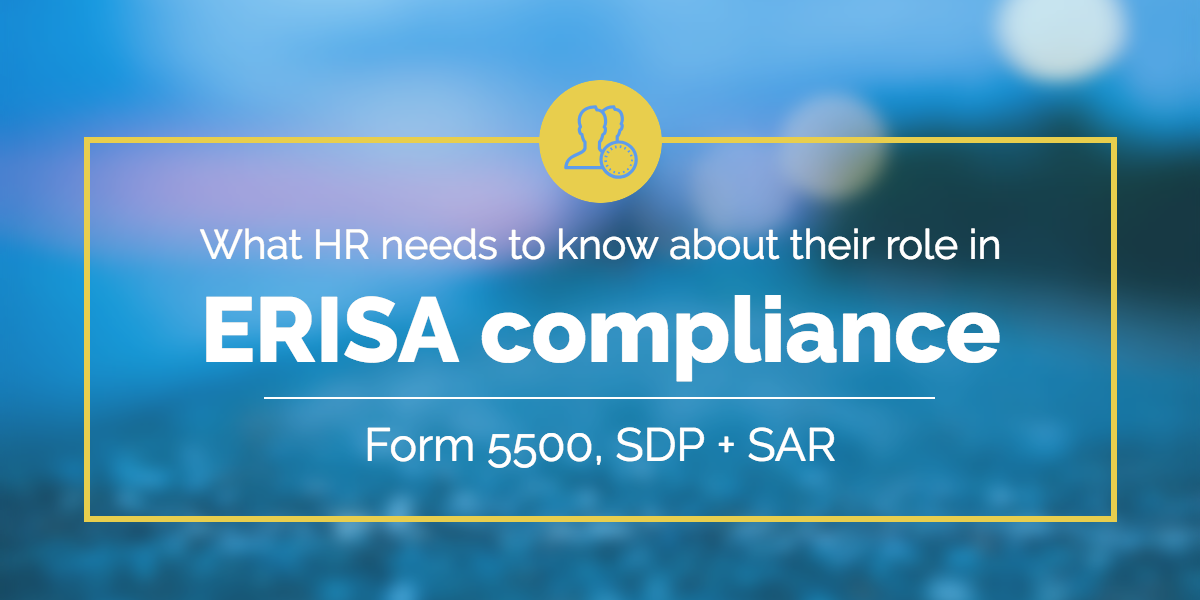
A lot of trends between generations in the workforce have emerged in the past few years: Baby Boomers are returning to the workforce for encore careers while millennials continue to place emphasis on their commitment to values above salary. Gen Z will have higher salary expectations than millennials and Gen X due to the difference in economies they grew up in. Despite all the differences in every generation, there’s one thing they all have in common: they will (one day) retire... and they’ll need some money put away when they do.
But Research from Northwestern Mutual revealed that one in five Americans has no retirement savings at all, and 46% (nearly half) have not taken any steps to prepare for the likelihood that they could outlive their savings. Of the Baby Boomer generation, one in three has between $0-$25,000 in retirement savings.
This is a big issue.
The U.S. Department of Labor (DOL) enacted the Employment Retirement Income Security Act of 1974 (ERISA) to protect the assets of Americans who have placed funds in retirement plans during their working lives. As a federal law, ERISA sets minimum standards for retirement plans in private industry. It’s intended to not only help protect retirement funds but also make them easily accessible to workers once they do retire.
Why does this matter for HR? Not only does the DOL continue to increase penalties for noncompliance, but you may have also noticed more ERISA cases popping up in the news lately as the courts crack down on noncompliance. As an HR professional, you know the importance of compliance with federal regulations and the consequences for noncompliance. With complex laws like ERISA, oftentimes the noncompliance isn't intentional, but happens due to a lack of education and understanding. You want to provide the right benefits and retirement plans for your employees. In order to do so, you need to understand the laws around those plans too.
First, let’s start with understanding ERISA as a law, then we’ll discuss HR’s role in compliance.
What is ERISA?
As noted earlier, ERISA exists to protect the assets of U.S. workers who place funds in retirements plans and to help them access those assets during retirement. In addition to retirement plans, ERISA also governs welfare benefit plans. Medical benefits, prepaid legal services, 401(k) plans, vacation benefits, and many other types of fringe benefit plans where the employer contributes to the cost of the plan are all subject to ERISA. Regardless of size, nearly all types of businesses— except churches and government entities— are subject to ERISA laws and compliance.
ERISA sets minimum standards for participation, vesting, benefits accrual, and funding. Under the law, a person may need to meet certain requirements for plan participation and rights to benefits. ERISA establishes funding rules so plan sponsors provide adequate funding for plans, and gives participants the right to sue for benefits and “breaches of fiduciary duty.” Through the Pension Benefit Guaranty Corporation (PBGC), ERISA guarantees payment of certain benefits if a defined plan is terminated.
Plan sponsors (employers) must provide participants (employees) with information about the plan along with any important information about the plan’s features and funding. Plan information should be furnished to employees regularly. Should the DOL request any plan documentation, the plan sponsor must be able to provide that information.
That’s where HR comes in.
HR and ERISA compliance: Form 5500, SDP, and SAR
While a lot goes into ERISA compliance, there are three key things HR should be sure to have on their compliance checklist: Form 5500, SDP, and SAR.
It’s common for employers to think it’s up to the insurance company or 401(k) provider to handle these documents, but it’s ultimately up to the employer to manage compliance with ERISA. If you’re using a third party to handle any of your benefits plans, they may provide some documentation, but it’s up to the employer to ensure everything is filed and furnished appropriately according to ERISA.
Form 5500
To collect information about employee benefit plans and assess the conditions and operations of those plans, the IRS, DOL, and PBGC developed the Form 5500 series. A sponsor of any plan subject to ERISA (welfare benefits or retirement plans) must complete and submit Form 5500 online using EFAST2 to report on their plans each year and maintain ERISA compliance.
Form 5500 must be filed on the last day of the seventh month following the close of the plan year. The reporting deadline for calendar year plans is July 31. If the deadline falls on a weekend or federal holiday, the form is due the following business day. If you need a little more time, you can request an extension with Form 5558 prior to the initial deadline for your plan.
Noncompliance with ERISA reporting isn’t cheap. Both the IRS and the DOL may impose fines or penalties for failure to maintain ERISA compliance. You could pay up to $28 per employee for failure to furnish a statement of benefits to employees and their beneficiaries or failure to maintain records for your plans. Failure or refusal to file Form 5500 could cost you as much $2,097 per day for each day the filing is overdue.
The penalties don’t stop there. Depending on your type of business and plan, the IRS and DOL can impose more fines (per employee, per day, or both) for noncompliance. If you’ve failed to file Form 5500, it may take as long as a year or more to receive a letter from the IRS, which means your fines could really add up. If you file your late return to the IRS before you receive a letter, you may be able to use the Delinquent Filer Voluntary Compliance Program to pay lower penalties.
SPD
ERISA requires employers to provide a Summary Plan Description (SPD) to each employee participating in the plan. The SPD should clearly list the benefits offered by the plan, rules for obtaining the benefits in the plan, and any guidelines for using those benefits, along with claims and repeals procedures. The SPD must also include a statement of ERISA rights.
A common misconception many employers and HR professionals believe is that the Evidence of Coverage or the Certificate of Insurance provided by the insurance company acts as the SPD for plan participants. These documents do not typically meet all the requirements of the SPD, so it’s best to provide a written SPD to all plan participants in addition to any evidence of coverage documents provided by the insurance company or benefits provider.
Employers must furnish SPDs to plan participants under the following timeline:
- Within 90 days to a new participant in a plan.
- Within 120 days if a new plan is established.
- Every five years a plan is in place.
- Every ten years if the plan has not changed.
Employers should be able to prove they have furnished the SPD to employees. The DOL recommends hand delivery, first-class mail, or electronic distribution (if employees have access to a computer in the workplace).
SAR
ERISA also requires plan sponsors to furnish plan participants and their beneficiaries with a Summary Annual Report (SAR) to summarize the information reported on the Form 5500 filed with the IRS. Plan sponsors should distribute the SAR within two months following the Form 5500 filing deadline for the plan (or nine months after the plan start date). If you filed for an extension on your calendar plan, you must furnish the SAR to plan participants by December 15. While the SAR is a summarized version of Form 5500, participants have the right to request a full copy of the form.
The SAR must include the following information:
- The plan’s value
- Any administrative fees paid from plan assets
- Any distributions paid to plan participants and their beneficiaries
- Notification of a plan participant’s right to request a copy of Form 5500
Managing compliance for your workforce can take a lot of work. Keeping up with ERISA compliance can be one of the most complex compliance situations HR faces—and the penalties for noncompliance are steep. But offering your employees retirement and welfare benefits plans can do a lot for your workforce. You’re helping employees in their everyday lives by offering benefits like medical and dental insurance, and you’re investing in their future by helping them plan for retirement. But it doesn’t stop there. By offering these plans, you’re staying competitive in the hiring market so you can attract top talent to join your workforce. Offering the right plans for your employees and staying on top of compliance for those plans can go a long way in helping your company’s bottom line.
